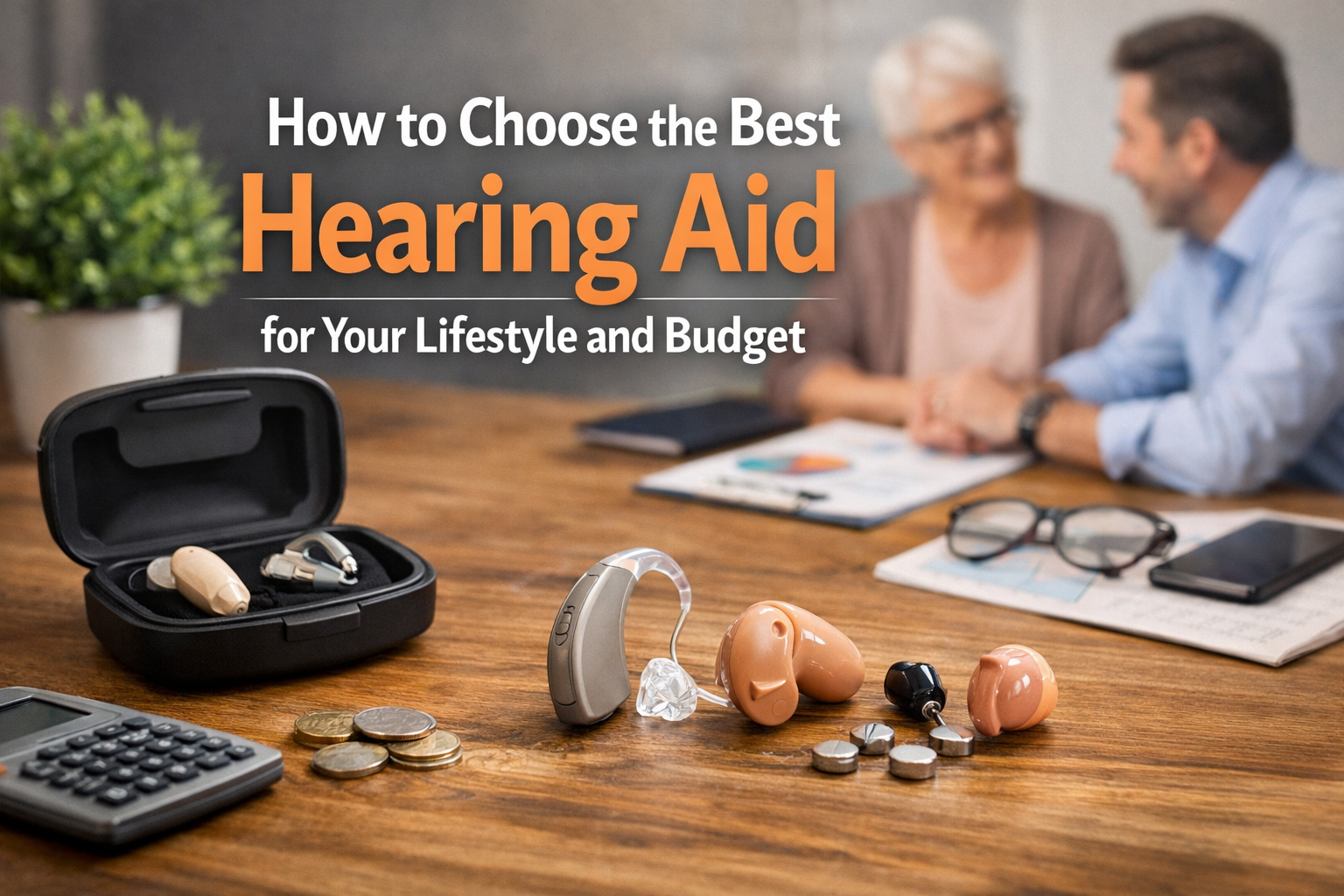Table of Contents
Choosing the right hearing aid can be overwhelming, especially with so many options on the market today. Whether you’re newly diagnosed with hearing loss or exploring new models to replace your current device, it’s essential to find a solution that fits both your lifestyle and your budget.
Hearing aids are not one-size-fits-all. What works for someone else may not work for you. The best hearing aid for you will depend on several factors, including the degree of your hearing loss, your daily activities, comfort, design preferences, and financial plan.
In this guide, we’ll walk you through everything you need to know about choosing the best hearing aid in 2025, from understanding hearing aid types and technologies to comparing the top hearing aid brands and learning how to match a device to your life.
Understanding Hearing Loss
Before you choose a hearing aid, it’s crucial to understand your level of hearing loss. A hearing test conducted by a qualified audiologist will determine your hearing range and help identify the most appropriate hearing solution.
Hearing loss typically falls into one of the following categories:
- Mild: Trouble hearing soft sounds or understanding speech in noisy environments.
- Moderate: Difficulty hearing regular conversations.
- Severe: Most sounds are inaudible; communication is very challenging.
- Profound: Only very loud sounds are detectable; hearing aids or cochlear implants may be needed.
Knowing your hearing level helps narrow down suitable hearing aids that can support your specific needs.
Different Types of Hearing Aids
Hearing aids come in several styles, each with its features, pros, and cons. Here’s a quick breakdown:
Behind-the-Ear (BTE)
- Sits behind the ear with a tube that delivers sound into the ear.
- Suitable for most levels of hearing loss.
- Larger size makes it easier to handle.
- Offers longer battery life and more features.
Receiver-in-Canal (RIC)
- Similar to BTE but smaller.
- The receiver sits inside the ear canal.
- Discreet and more comfortable.
- Best for mild to severe hearing loss.
In-the-Ear (ITE)
- Custom-moulded to fit the outer ear.
- Easier to insert and remove.
- Suitable for mild to severe hearing loss.
In-the-Canal (ITC) and Completely-in-Canal (CIC)
- Even smaller and more discreet.
- Fit partly or completely inside the ear canal.
- Best for mild to moderate hearing loss.
- It may not be ideal for those with dexterity issues.
Choosing the Best Hearing Aid for Your Lifestyle
Your daily routine should play a big role in your choice. Here’s how different lifestyles match with specific features:
Active Lifestyle
If you’re always on the move, attending events, working, or exercising outdoors, consider:
- Wind noise reduction
- Water and sweat resistance
- Directional microphones
- Bluetooth connectivity
Quiet Lifestyle
If you spend more time at home, reading, or in small social gatherings, look for:
- Comfort and ease of use
- Basic noise reduction
- Simple volume controls
Social Lifestyle
If you regularly attend meetings, go out with friends, or participate in group activities, consider:
- Advanced speech clarity features
- Multiple sound environment settings
- Rechargeable batteries
Tech-Savvy Lifestyle
If you enjoy gadgets, streaming, and smart devices, choose digital hearing aids 2025 with:
- Smartphone integration
- Customizable apps
- AI-driven sound adjustments
Top Hearing Aid Features to Look For
Here are some must-have features in modern hearing aids:
- Noise reduction: Helps filter out background noise.
- Rechargeable batteries: Convenient and eco-friendly.
- Bluetooth: Connects to phones, TVs, and computers.
- Automatic adjustments: Adapts to changing sound environments.
- Directional microphones: Focuses on speech in front of you.
- Tinnitus masking: Provides relief if you suffer from ringing in the ears.
Also, consider having ear measurements done for optimal fit and comfort. Setting Your Budget for Hearing Aids
Top Hearing Aid Brands in 2025
Let’s explore some of the top hearing aid brands in 2025, known for innovation and reliability.
Signia
- Sleek designs with great performance
- Rechargeable models with AI-assisted sound
- Known for Signia Assistant for real-time adjustments
Phonak
- Excellent for speech clarity
- Offers water-resistant models
- AutoSense OS for seamless environment changes
Starkey
- Strong focus on wellness and fall detection
- Offers hearing aids with fitness tracking
- Ideal for seniors
ReSound
- Great Bluetooth and app integration
- Organic Hearing Philosophy for natural sound
- One of the best-rated hearing devices globally
Choosing a brand also means choosing customer service, repair options, and future upgrades
How to Try and Test Before Buying
Most clinics offer trial periods for new hearing aids. Here’s what you should do:
- Test the device in different environments (home, outdoors, restaurants)
- Try adjusting the volume and settings yourself
- Ask about follow-up support and servicing
- Track how comfortable it feels after a few hours of use
This testing phase is crucial before making a financial commitment.
Should You Choose Digital Hearing Aids?
Modern hearing aids are almost always digital. Analog models are largely outdated. Digital hearing aids 2025 come with numerous advantages:
- Better sound processing
- Noise and feedback control
- Customization through apps
- Compatibility with smart devices
These are suitable for nearly all levels of hearing loss and all lifestyles.
Buying Tips for First-Time Users
- Always get a professional hearing test first.
- Understand your lifestyle needs.
- Compare 2–3 different models.
- Check warranty, support, and service options.
- Choose a model that fits your budget
- Don’t be afraid to ask for a second opinion.
Where to Get Professional Help
For comprehensive service, visit The Hearing Centre Singapore. We offer everything from hearing tests and fittings to cochlear implants and aftercare.
- Free consultations
- Maintenance plans
- Repair services
- Follow-ups and training for new users
Conclusion
The right hearing aid can greatly improve your life, whether it’s participating in conversations, enjoying music again, or simply hearing nature’s sounds. By understanding your needs, learning about available technology, and working with professionals, you can find a solution that fits both your lifestyle and your budget.
Choosing from the top hearing aid brands and focusing on the best-rated hearing devices of 2025 ensures you’re getting reliable, high-quality options that are future-ready. Don’t rush the process, and don’t hesitate to seek support.
Frequently Asked Questions:
For seniors, easy-to-use devices from Starkey or Phonak with automatic volume control and wellness features are ideal.
Most hearing aids last between 4 to 5 years, depending on care and technology upgrades.
Yes, digital hearing aids 2025 provide better sound quality, noise reduction, and personalization.
Yes, most modern hearing aids have Bluetooth that connects with smartphones and TVs.
Yes, a professional hearing test helps match the right hearing aid to your needs.
Not always. The best-rated hearing devices fit your specific hearing loss, lifestyle, and budget, not just the price tag.
Brands like Starkey, ReSound, Signia, phonak offer very discreet models like CIC or RIC that are almost invisible.
Yes, many clinics offer a 1 week trial period to test out different models.
Brands like Starkey, Phonak, Signia, and ReSound offer a good balance between price, performance, and support.
Visit The Hearing Centre Singapore for professional hearing aid consultations and to explore the top hearing aid brands in one place.

Evlin is passionate about helping people with hearing loss. With years of experience in audiology, she has diagnosed and treated a wide range of hearing conditions across all age groups. She is accredited to conduct comprehensive hearing assessments and provide treatments for patients from newborns to the elderly. Committed to personalized care, she strives to empower patients to fully engage in life with better hearing.
Designation: Clinical Audiologist
Qualification: Bachelor of Health Science (Honours) (Audiology), University of Science Malaysia
Membership: .Society of Audiology Professionals in Singapore (SAPS)

